Futbol Değer Zinciri: Brezilya - Portekiz - üçüncü ülkeler arasındaki işlemler dizisi
Alfredo Ruiz Brichs & Diogo Gama tarafından ortaklaşa yazılmıştır Alfredo Ruiz Brichs, LinkedIn Diogo Gama, LinkedIn
Giriş
Küresel bir takım sporu olan futbol, sadece sahada yaşananlarla değil, aynı zamanda kulüplerin sportif ve ekonomik başarısını yönlendiren karmaşık bir değer zinciriyle de tanımlanır. Bu zincir dört temel sütuna dayanır: erken yetenek tespiti, uygun maliyetle stratejik oyuncu kazanımı, hem sportif performansı hem de piyasa değerini en üst düzeye çıkarmak için yetenek gelişimi ve nihayetinde döngüyü geri besleyen karlar elde etmek için oyuncu satışı. Bu ekosistem içinde çeşitli aktörler - gözlemciler, menajerler, gençlik akademileri, kulüpler ve antrenörler - kritik roller oynamaktadır ve doğru ve zamanında bilgiye erişim, etkili karar verme için çok önemlidir. Bu makale, paradigmatik bir vakaya odaklanarak bu değer zincirini yansıtan piyasa eğilimlerini incelemektedir: yetenek “tedarikçisi” olarak hareket eden Brezilya kulüplerinden, bu oyuncuları daha yüksek gelirli liglere satmak için geliştirip yeniden değerlendirerek “dönüştürücü” olarak hizmet veren Portekiz kulüplerine oyuncu transferleri. Veriye dayalı bir örnek üzerinden, bu dinamiğin Portekiz kulüplerine nasıl önemli kârlar sağladığını ve küresel futbol pazarındaki stratejik konumlarını nasıl güçlendirdiğini göstereceğiz.
Değer Zinciri
Yetenek tespiti, zincirin ilk halkasıdır. Özellikle Brezilya'da gözlemciler ve gençlik akademileri, potansiyeli olan oyuncuları rakiplerinden önce tespit etmek için çok önemlidir. Zengin futbol geleneği ve tutkulu nüfusuyla Brezilya, sürekli bir genç yetenek akışı üretiyor. Flamengo, Palmeiras veya Santos gibi kulüpler, oyuncuları erken yaşlardan itibaren belirleyip yetiştiren birer fidanlık görevi görür. İkinci adım ise stratejik satın almalardır. Porto, Benfica veya Sporting CP gibi Portekiz kulüpleri, scouting ağları ve gelişim platformları olarak sahip oldukları itibar sayesinde bu yetenekleri nispeten düşük fiyatlarla elde etme konusunda oldukça başarılı. Bu işlemler genellikle oyuncular henüz en yüksek piyasa değerine ulaşmamışken gerçekleşir ve finansal riski en aza indirir. Üçüncü halka olan gelişim, Portekiz kulüplerinin önemli bir değer kattığı noktadır. Yetenekli antrenörler, gelişmiş antrenman metodolojileri ve Primeira Liga veya UEFA Şampiyonlar Ligi gibi üst düzey Avrupa müsabakalarına maruz kalma sayesinde oyuncular teknik, taktik ve fiziksel becerilerini geliştirir. Bu süreç sadece kulübün sportif başarısına katkıda bulunmakla kalmaz, aynı zamanda oyuncuların piyasa değerini de önemli ölçüde artırır. Son olarak, bu oyuncuların Premier Lig, La Liga veya Serie A gibi daha zengin liglere satılması zinciri tamamlar. Portekiz kulüpleri, oyuncuları ilk yatırımlarının çok üzerinde meblağlara transfer ederek önemli karlar elde ediyor, bu kazançları yeni yeteneklere yeniden yatırıyor ve döngüyü devam ettiriyor.
Ekosistemdeki Kilit Aktörler
Bu zincirdeki her aktör belirli bir rol oynamaktadır. Gözlemciler piyasa istihbaratı sağlayarak Brezilya'da gelişmekte olan yetenekleri belirler. Menajerler, oyuncuların ve kulüplerin çıkarları arasında uyum sağlayarak görüşmeleri ve transferleri kolaylaştırır. Brezilya gençlik akademileri başlangıç noktasıdır ve oyuncuları erken dönemlerinde şekillendirir. Portekiz kulüpleri dönüşüm merkezleri olarak hareket ederken, antrenörler oyuncuların teknik ve kişisel gelişiminin mimarlarıdır. Tüm bu aktörler, kararlarını optimize etmek için performans verilerinden piyasa analizine kadar yüksek kaliteli bilgilere güveniyor.
Süreç
Kapsam: Brezilya'dan Portekiz'e gerçekleşen en önemli transferleri 15-16 ile 21-22 sezonları arasında seçiyoruz (toplam 52 oyuncu)
1. Yetenek belirleme: Brezilya'dan Portekiz'e giden oyuncu sayısı: 52 oyuncu
2. Yetenek satın alma: Brezilya (tedarikçi) ile Portekiz (dönüştürücü) arasındaki brüt gelir: 145.160.000 €
3. Yetenek geliştirme: Bu oyuncuların kariyerleri:
a. Aynı kulüpte kalanlar: 2 oyuncu
b. Başka pazarlara transfer olanlar: 32 oyuncu (38 transfer)
c. Portekiz'de kalanlar: 5 oyuncu
d. Emekli olanlar veya kulüpsüz: 9 oyuncu
4. Yetenek satma: Portekiz'den (dönüştürücü) diğer ülkelere (muhtemelen alıcı ama bazen dönüştürücü ya da nadiren tedarikçi) yapılan satışlardan elde edilen brüt gelir (katma değer):
a. Yatırım: 145.160.000 €
b. Elde edilen (üçüncü takımlara yapılan transferler): 320.741.000 €
c. Kâr: 175.581.000 €
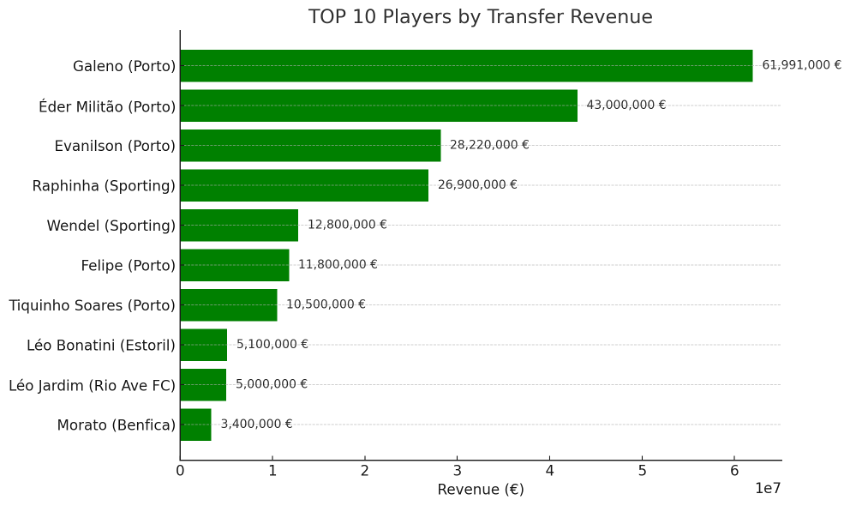
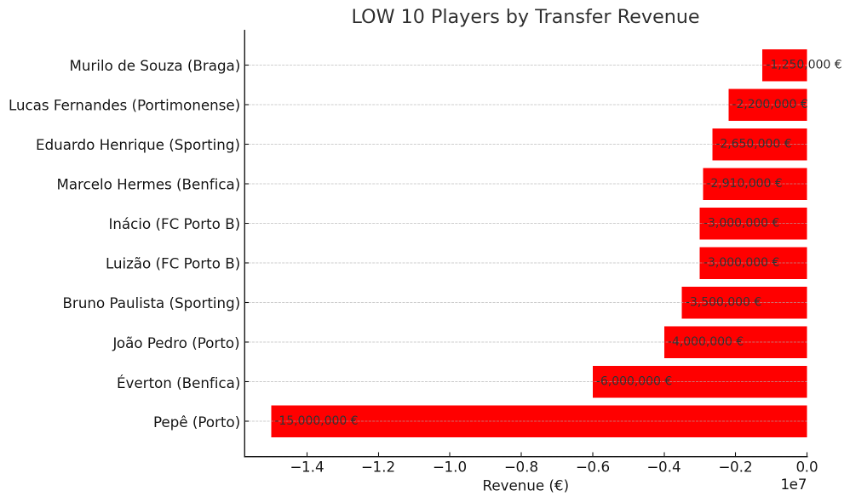
Bu Oyuncuların Mevcut Durumu (3. taraflara transfer edildi)
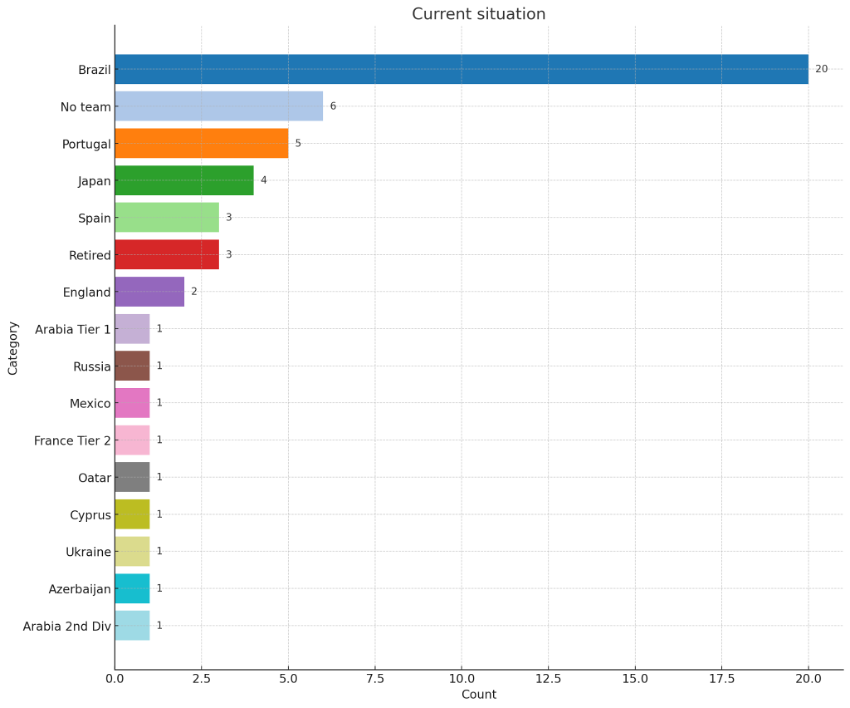
Dayanışma Mekanizması Toplam (Potansiyel) Portekiz'den yapılan dış transferlerden elde edilen gelir:
14,730,000 €
Pazar Eğilimleri
Bu Brezilya-Portekiz dinamiği birkaç pazar trendini yansıtmaktadır:
Küresel Scouting: Portekiz kulüpleri, Brezilya'daki gözlem ağlarını geliştirerek gelişmiş veri ve istatistiksel analizler kullanmakta ve 21 yaş altı yetenekleri belirlemektedir. Analizimize göre (2015-2022), bu transferlerin %’lik kısmı 21 yaş altı oyuncuları içermektedir.
Stratejik Yatırım: Portekiz kulüpleri, uygun fiyatlarla (€5-15 milyon) oyuncu alıp, çok daha yüksek rakamlara (€25-80 milyon) satarak getirilerini maksimize etmektedir. Ancak, bu stratejide giderek daha fazla rol oynayan Elit Kulüpler (Şampiyonlar Ligi hedefi olanlar) dikkate alınmalıdır.
Gelişim Platformu: Primeira Liga, Güney Amerikalı oyuncular için rekabet seviyesi ve Avrupa’daki görünürlüğü sayesinde ideal bir gelişim ortamıdır.
Ekonomik Yararlar: Porto, Sporting veya Benfica gibi kulüpler yüksek kâr marjları elde ederek, altyapı, scouting ve yeni transferlere yeniden yatırım yapmaktadır.
Ayrıca:
Tüm oyuncu yatırımlarının yalnızca %40,4'ü kârla sonuçlanmaktadır; bu, sonuçlarda önemli bir Pareto benzeri dengesizliği göstermektedir.
İşlemlerin küçük bir kısmı büyük kârları sağlar; bu da çoğu yatırımın kâr getirmediğini ortaya koyar.
Bu model, futbol transferlerinin yüksek risk-yüksek getiri doğasını yansıtır; başarı birkaç son derece kârlı anlaşmaya bağlıdır.
Yatırım = aynı kulüpte kalmaya devam eden oyuncular
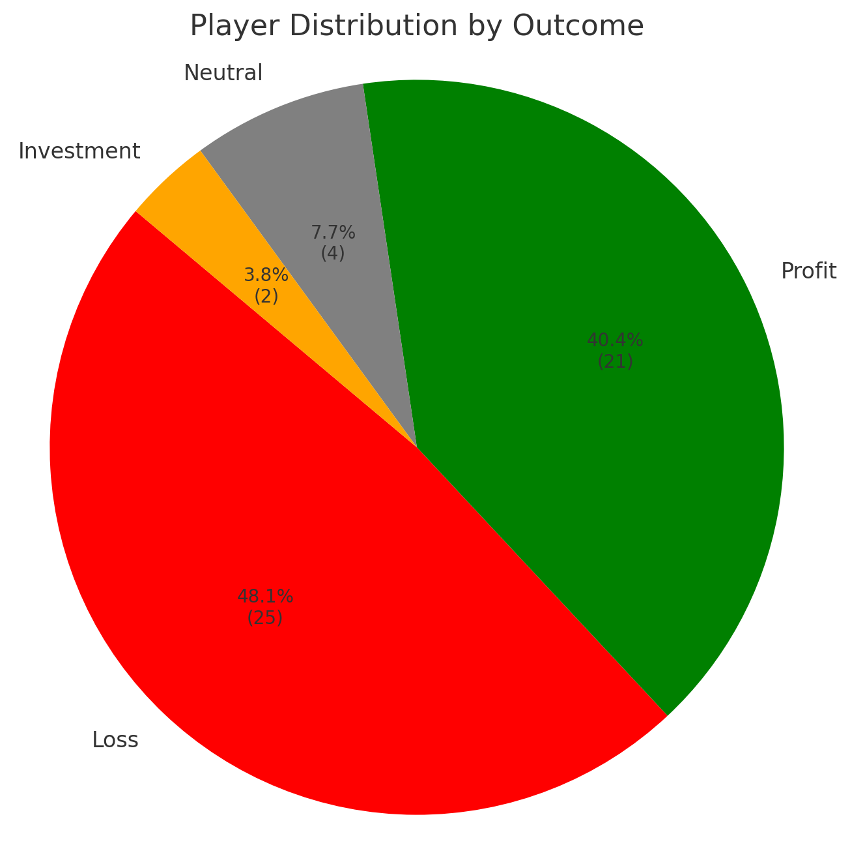
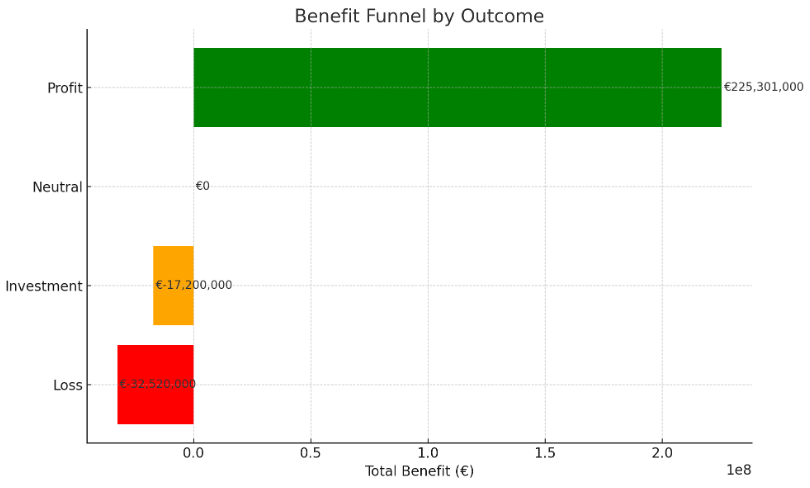
Brezilya’dan transfer edildikten sonra, kariyerlerinin zirvesindeki oyuncular genellikle satın alan (ve zengin) kulüplere transfer edilir, bu da en yüksek kâr oranlarını sağlar. Portekiz içindeki yerel transferler genellikle finansal kazançtan çok oyuncu gelişimine hizmet eder. Brezilya’ya geri dönüş transferleri ise genellikle kariyerinin sonuna yaklaşan veya formdan düşmüş oyuncuları kapsar; bu tür hareketler genellikle köklere dönüş olarak görülür ve en düşük kâr oranlarını üretir.
Conclusione
“Futboldaki değer zinciri — tespit, satın alma, geliştirme ve satış — Portekiz kulüplerinin ustalaştığı stratejik bir modeldir ve Brezilyalı yetenekleri hammadde olarak kullanmaktadır. Bu yaklaşım yalnızca sportif başarıyı garanti etmekle kalmaz, aynı zamanda rekabetin yüksek olduğu pazarda kulüplerin ekonomik sürdürülebilirliğini de sağlar. Bilgiyle desteklenen scouts, menajerler, akademiler, kulüpler ve antrenörler arasındaki iş birliği bu dinamiği beslemektedir. Militão veya Raphinha gibi örnekler, Portekiz kulüplerinin dönüştürücü rolünü, önemli kârlar yaratarak ve küresel futbol ekosistemindeki kilit rollerini pekiştirerek nasıl yerine getirdiğini gösteriyor. Veri ve hızlı karar almanın kritik olduğu bir dünyada, bu değer zinciri önümüzdeki yıllarda piyasa trendlerini şekillendirmeye devam edecek.
GelecekBu model devam edecek mi? Yoksa Portekiz kulüpleri bu modeli yeniden düşünmek zorunda mı kalacak? Futbol dinamiktir ve Brezilya'ya ithal edilen know-how ve Çoklu Kulüp Platformları sonuç vermeye başladığında, bu hala geçerli bir model olacak mı?



